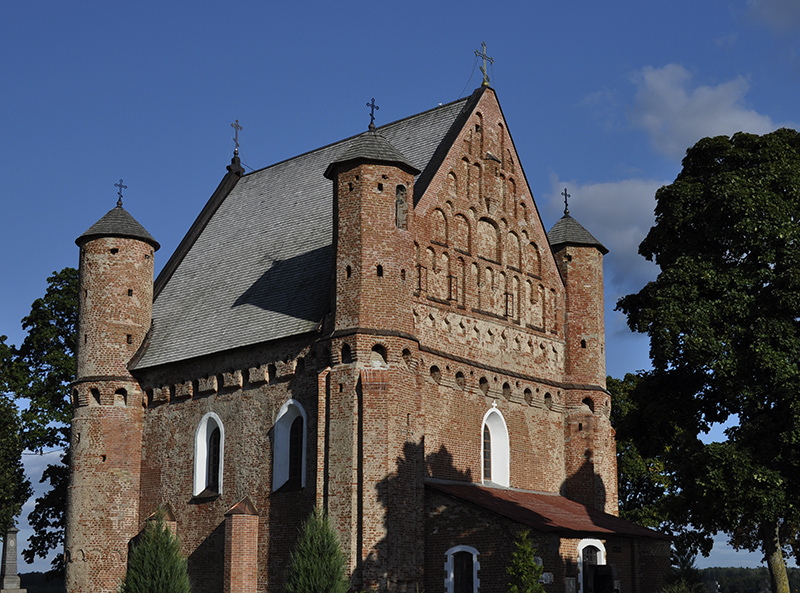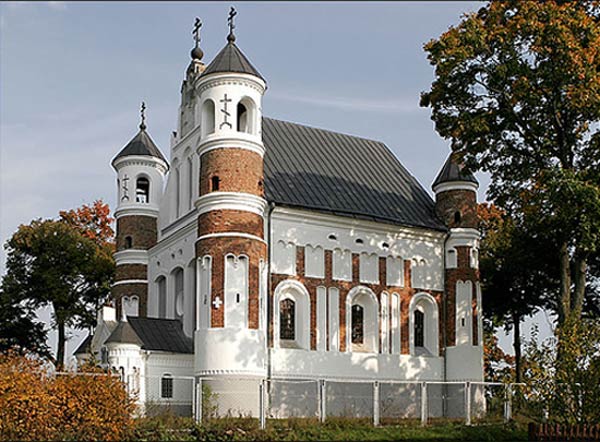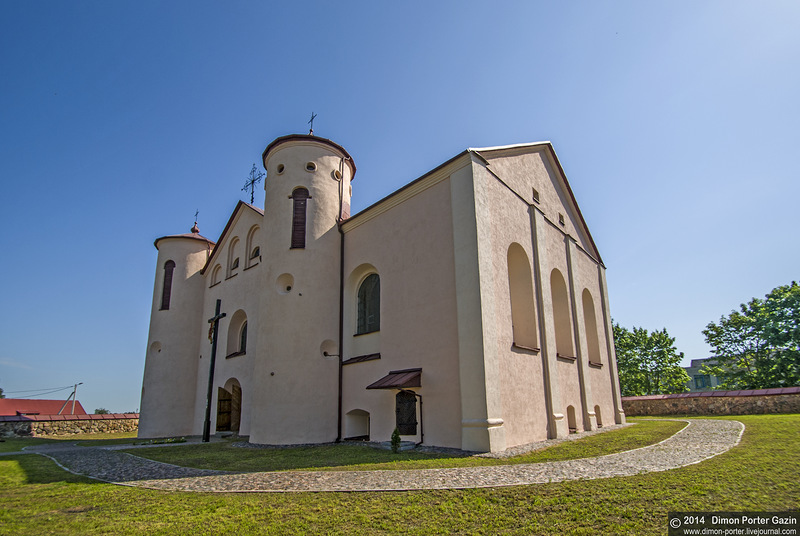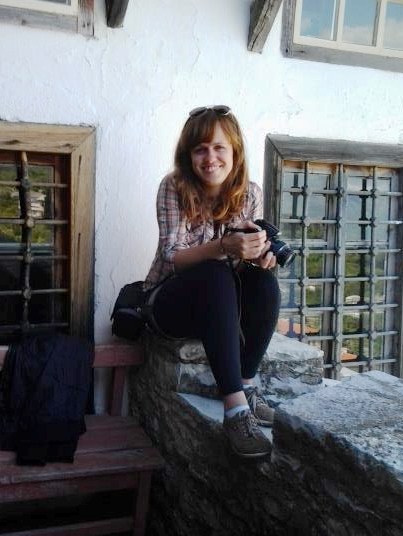by Anastasiya Scherbina*
Belarus is one of the least known and recognizable country in the East Europe. Owing to its political and economic current situation, Belarus remains as a white spot on the map for the rest of the world. Nevertheless, it has own rich history with ups and downs, prosperity and occupation, world-famous figures and their achievements, features and mentality of people.

The Church of St. Michael
Location at the intersection of the Eastern and Western worlds, on the edge of the Catholic and Orthodox Churches influenced on the architecture and development of religious heritage as well. Throughout many centuries several religions were replacing one another depending on what neighbouring country occupied Belarus. Accordingly, the architecture of all churches and temples were rebuilt and modified number of times in order to correspond to new requirements. Belarusian sacral monuments were suffering from destruction and abundance. Only for the last century churches were under the influence of several waves of demolition – World War I, World War II, church oppression during the Soviet period. In wartime churches were used as storage for weapons and ammunitions, furthermore, when enemy troops were leaving, they frequently took with them all saint relics, church treasures and icons. In Soviet times numerous monuments of sacral architecture were blown up and wiped off the face of the earth as a result of combat with “the opium of the people”. Those few monuments of religious heritage that are preserved by miracle and survived until today have great value for Belarusian people, their culture and self-determination. Furthermore, analysis of the history of religious heritage reflects the most significant and important milestones in the Belarusian history.
Fortified churches and synagogues
Particular interest and importance amount Belarusian churches are paid to fortified churches – a mixture of church and fortress, adopted to short or long-term protection by incorporation into the architecture of the sacral buildings a number of military characteristics, such as flanking towers, battlements, thick walls and embrasures. Thick walls reached up to two meters, towers had multilevel loopholes for archers and arbalesters who were able to combat on the close, medium and long-range terms, temples were surrounded by a rampart occasionally. Fortified churches and synagogues were widely spread in XIV-XVII centuries, mainly in the late Gothic period. As a consequence, the majority of churches were built in the Gothic style, but with some architectural features typical only for The Grand Duchy of Lithuania that included at that period of time the entire territory of the present Belarus. Only handful out of a large number of fortified churches has survived until the present. Today we describe and make a historical digression concerning three of them – the most significant and spectacular fortified churches of Belarus.
13 km away from the historic town of Slonim in the Grodno region there is a village, Synkovichi, that in the last decade became more popular for tourists and pilgrims. The reason is one of the most mysterious churches – the Church of St. Michael that during its long history was Orthodox, Catholic and Greek-Catholic. The exact date of the construction of this architectural marvel is still a matter of controversy among experts. Kulagin indicates the date of construction of the church as in 1407, and Vladimir Chanturia – the end of the XV or the beginning of the XVI centuries. The book “Orthodox architecture of Belarus”, published under the auspices of the Orthodox Church, it is alleged that the temple was built in the first half of the XVI century. In turn, architectural historians A. Kushnerevich and T. Gabrys agree that Synkovichi temple is dated from the beginning of the first half of the XVI century. There is also an opinion that the construction was rebuilt in 1405-07 years from the Prussian castle that was dated from the beginning of the XIV century. According to the legend, in 1382 the Grand Duke Vytautas after escaping from Jagaily’s captivity found shelter within the walls of Synkovichi fortress. In gratitude for the support and shelter the Grand Duke financed the reconstruction of the fortress into the Orthodox Church in 1407.
After Church Union of Brest in 1596 Synkovichi church moved to the Greek-Catholic Church, with the abolition of Union of Brest the church was returned to the Orthodox. Walls of the temple were never rebuilt, but only the roof was changed. In 1880-81 the roof of the church was replaced, the porch and the dome over the apse were built, but the dome over the central part of the temple was dismantled. In 1891 the two-high four-sided bell tower in front of the church was built. After World War I services in the church were alternately Catholic and Orthodox, and in 1926 it became again as a part of Greek-Catholic Church. After World War II the temple was used as a warehouse and vegetable store. The temple was badly damaged during Soviet period. In 1956 it was closed and during 30 years used as a warehouse. Only in 1991 the temple was returned to believers and Orthodox Church. In 2011 on the southern wall of the temple under the layers of paint and plaster ancient graffiti were discovered that contain a quotation from the Gospel in Ancient Greek language.

Another significant beautiful temple-fortress is located in the village Murovanka, Shchuchyn District, the Grodno region. The exact date of building is also unknown. For the long period of time it was considered that the official date of construction is 1407. However, detailed research of the monument proved that the church was built between 1516 and 1542. By this time the area had the name Murovanka (“mur” in Belarussian means “fort”) owing to single fortified tower that was later rebuilt into a temple. In 1598 in spite of the willing of local community the church was turned to the Greek-Catholic. During the Russian-Polish war in 1657 the church was badly destructed. Afterwards it was affected adversely by fire and troops of Swedish king Charles XII. The church was repeatedly attacked judging from the traces of bullets and buckshot on the walls.
In 1795 the Grodno region was incorporated into the Russian Empire. On his way from Vilnius Emperor Alexander I visited the church and ordered to repair it to Slonim landowner. But the repair started only 5 year later. Before the beginning of XIX century church had lowered iron doors. During the restructuring in 1817 and 1871-1872 the porch was attached to the main façade, West towers were built, the roof was lowered, eaves were arranged and windows were enlarged. Since 1864 a parochial school worked in the church, after the fire the residents built a college at the church. In 1906 Vilnius Holy Spirit brotherhood renovated the church. In 1928 Murovanka church was taken away from Orthodox Church and given to Catholic by Polish authorities. In 1993 it was returned to the Orthodox and became the parish center that includes 8 surrounding villages. Nowadays Sunday school organized in the church.

Another fortified church with original specificity is a church of St. John Baptist, located in the village Kamai, Postavy district, Vitebsk region. The initiator of the construction of the church in the village Kamai was the owner of the village – Yang-Rudomino Dusyatsky. Construction of the church was carried out between 1603 and 1606, the architect’s name is unknown. In 1643 the hospital was founded in the church. During the Russian-Polish in 1654-1657 the temple was burnt by Russian troops and, as a result, vaults of the church collapsed. During the restoration the column was dismantled, the temple got one nave, the main space was blocked by wooden vault. During the Great Northern War (1700-1721) the temple was damaged with fire and guns, until now the walls of the church keep Swedish cannon-balls from that time. In 1726-1736 and in the middle of the XIX century it was executed murals on the vaults in the form of bunches of plants and flowers. In 1778 a large chapel with a crypt was added on the south side of the temple. In 1861 the church was renovated and rebuilt slightly. The church of St. John Baptist is one of the very few Catholic churches in Belarus that was not ever closed since the founding, except restoration time. The temple was open even in Soviet period. In 2007 one of the towers was damaged during a hurricane. In 2010-2011 the temple was restored.
In 2004 fortified churches of Belarus were inscribed in UNESCO Tentative List as Edifices for Worship of Fortress Type in Belarus, Poland and Lithuania with criteria (i). Unfortunately, nowadays local authorities face to the lack of resources for further research and nomination sites to UNESCO List. Recent research in Synkovichi church, for instance, was initiated and done by local activists with their own founds and during their free time that, obviously, is not enough for proper maintenance and studies of the monument. However, this region has still a great number of mysteries and challenges. Old archives mention long underground routes with help of them it was possible to come to the church from all surroundings villages during attacks. Until today they were not found yet. Furthermore, researches and proper maintenance allows saving authentic monuments and escaping the necessity of rebuilding and restoring churches.
In the past time these churches repeatedly saved people, and now they are in great need of our protection.

* Anastasiya Scherbina has an experience of working in the voluntary and non-profit sectors. From 2007-2011 she studied at European Humanities University, a Belarusian University in exile in Lithuania, which she successfully graduated from the program “Cultural Heritage and Tourism”. From 2012-2015 she studied at Brandenburg University of Technology Cottbus-Senftenberg that she graduated as Master of Arts from the program “World Heritage Studies”.
She did her internship in non-governmental organization Cultural Heritage without Borders in Gjirokastra, UNESCO World Heritage Site of Albania. Since 2015 she has managed a number of projects concerning cultural heritage in Belarus with European support attempting to integrate Belarus into European society.
Born in 1989, she currently lives in Germany.





Follow us: